10 Best Diabetic Dog Food Brands (Non-Prescription) in 2025
Quick Guide
- What is the Best Dog Food (Non Prescription) for Diabetic Dogs?
- What Do You Need to Know About Diabetes in Dogs?
- Tips for Treating and Managing Diabetes in Dogs
- What to Look for in a Dog Food for Diabetes
- The 10 Best Dog Foods for Diabetes
- 5 More Top-Rated Glucose Management Dog Foods
- Wellness CORE Grain-Free Reduced Fat Turkey & Chicken Recipe Dry Food
- Farmina Natural & Delicious Chicken & Ancestral Low-Grain Formula Dry Food
- Merrick Grain-Free Healthy Weight Recipe Dry Food
- Nulo Freestyle Turkey & Sweet Potato Recipe Grain-Free Dry Food
- Nature’s Variety Instinct Raw Boost Healthy Weight Grain-Free Chicken Recipe
- Frequently Asked Questions
- Diabetic Dog Food – RECAP
According to the American Diabetes Association (ADA), over 30 million Americans have diabetes. This makes diabetes a disease of near-epidemic proportions, and it is closely linked to the obesity epidemic. Both of these conditions are commonly thought of as human diseases, but you may be surprised to learn that both can affect dogs as well.
Not only do dogs have the potential to develop diabetes, but the problem is surprisinglshry common. In fact, statistics from Banfield Pet Hospitals suggest that there was a nearly 80% increase in the number of dog diabetes cases between 2006 and 2015. Canine diabetes is a serious condition but also a manageable one and, in some cases, it may even be reversible.
The key to managing your dog’s diabetes is to feed him a healthy diet. A wholesome and nutritious diet will help your dog maintain a healthy bodyweight, and it will help keep his blood sugar stable as well. In this article, we’ll explore the subject of canine diabetes including treatment options. You’ll also see our diabetic dog food list including our top 10 picks.
What is the Best Dog Food (Non Prescription) for Diabetic Dogs?
- The Farmer’s Dog Customized Human-Grade Dog Food – Healthiest
- Taste of the Wild Southwest Canyon Grain-Free Dry Food – Most Popular
- American Journey Grain-Free Chicken & Sweet Potato Recipe – Most Affordable
- Blue Buffalo Wilderness Senior Chicken Recipe Dry Food
- Zignature Turkey Limited Ingredient Formula Dry Food
- Wellness CORE Grain-Free Reduced Fat Turkey & Chicken
- Farmina Natural & Delicious Chicken & Ancestral Low-Grain
What Do You Need to Know About Diabetes in Dogs?
You’ve almost certainly heard of diabetes, but how much do you really know about it? And how does canine diabetes differ from diabetes in humans? Diabetes is a type of endocrine disorder that affects your dog’s ability to produce insulin. Insulin is a hormone created in the pancreas which is released in response to an increase in blood sugar.
When your dog eats, his body breaks down the food into its core components which include glucose. That glucose then enters the bloodstream for dispersal throughout the body and, in response, the pancreas starts producing insulin. Insulin enables cells in the body to absorb glucose from the bloodstream so they can use it as a source of energy. As the cells absorb glucose, your dog’s blood sugar level tapers back down to normal, and insulin production slows down.
The problem occurs when your dog’s ability to produce insulin becomes impaired or if his body stops responding to it properly. Chronically high blood sugar will cause your dog’s pancreas to work double time to produce enough insulin and, as a result, it may end up taking more insulin to achieve the desired result, or the pancreas could start to dysfunction. That’s when diabetes occurs.
Diabetes is a condition that typically develops over time and may produce symptoms such as:
- Increased thirst
- Frequent urination
- Loss of appetite
- Dehydration
- Low energy
- Poor coat condition
- Depression
- Dry, flaky skin
- Muscle weakness
- Cataracts
- Weight loss
- Weakness in hind legs
Diagnosis of diabetes in dogs requires blood and urine tests. When testing your dog’s blood, the vet will be looking for an above-normal glucose level – normal levels for dogs are between 60 and 125 mg/dl. Your veterinarian may also test your dog’s urine for ketones. In addition to testing for ketones, your vet will also check the urine for signs of bacteria since they tend to flourish in high-sugar environments.
There are two types of diabetes in both humans and dogs. Type 1 diabetes is also known as diabetes mellitus, and it occurs when the pancreas is damaged or otherwise not functioning properly. Type 2 diabetes is known as adult-onset diabetes in humans but is often referred to as insulin-resistant diabetes in dogs. It occurs when the body is no longer able to utilize insulin as well as it should.
Tips for Treating and Managing Diabetes in Dogs
Both Type 1 and Type 2 diabetes are very serious conditions for dogs. Left untreated, diabetes can lead to some serious complications. Chronically elevated blood sugar will damage the internal organs and, without insulin to enable cells to absorb glucose from the bloodstream, the cells will be starved for energy. Eventually, your dog may develop kidney problems, heart failure, and eye problems.
Though diabetes in dogs cannot be cured, it can be managed through various treatment options.
Dogs with Type 1 diabetes will require insulin injections as well as dietary changes to lose weight and manage their blood sugar. Dogs with Type 2 diabetes typically don’t require insulin injections because the condition can be managed with dietary changes, weight loss, and oral medications. The goal of treatment for diabetes is to stabilize the dog’s blood sugar levels and to help him achieve a healthy body weight. Once the dog’s condition is stable, he may no longer need insulin injections.
While your dog requires insulin therapy, he’ll probably need injections twice per day. Unfortunately, it can take some time as well as a fair bit of trial and error to determine the right dosage. Your vet will need to test your dog’s blood every couple of hours to monitor changes in blood sugar in response to insulin injections. It may take several months of weekly or bi-weekly testing to find the right dosage. In the meantime, you’ll need to keep your dog’s diet and exercise habits as consistent as possible.
Here are some additional tips for treating and managing canine diabetes:
- Be consistent about what, how much, and when you are feeding your dog while completing a blood glucose curve – this information is essential to determine the right dosage.
- Maintain your dog’s twice-daily insulin injections according to your vet’s advice while keeping other aspects of his life (diet, exercise, and stress levels) as consistent as possible.
- Consider timing your dog’s insulin injections to be given right after a meal – this enables you to lower the dose if needed, if your dog doesn’t eat as much at one meal.
- The first few months of diabetes treatment can be frustrating and time-consuming but most dogs that make it through live another two years.
- Most dogs do not completely recover from diabetes, but the condition can be managed, and the dog can still live a healthy life with regular exercise and dietary management.
What to Look for in a Dog Food for Diabetes
Though diabetes can affect any dog, it is most common in middle-aged and senior dogs as well as dogs that are overweight or obese. There are also certain breeds more susceptible to diabetes than others – examples include Pugs, Bichon Frises, Dachshunds, Miniature Schnauzers, Beagles, Miniature Poodles, and Fox Terriers. Female dogs are also more likely to get diabetes, particularly unspayed females.
Treatment of diabetes in dogs should be monitored by a veterinarian. Your vet will be able to determine which type of diabetes your dog has and how to best manage it. In addition to insulin treatments, your vet may also recommend dietary changes to help your dog lose weight and to manage his blood sugar.
Here are 5 key things to look for in a dog food for diabetes:
- High in protein. Lean protein is the foundation of a healthy diet for dogs, especially if your dog needs to lose weight. Focus on high-quality animal proteins like chicken, turkey, and fish.
- Low-to-moderate fat. Healthy fats provide a concentrated source of energy for dogs as well as support for his skin and coat. For overweight dogs, however, you want to limit the fat content of the dog’s diet as a means of controlling his calorie intake.
- Low glycemic index. Most commercial dog foods contain carbohydrates, and it’s completely fine as long as they come from digestible, nutritious sources. For dogs with diabetes, you want to limit the carb content as much as possible and stick to low-glycemic carbs to avoid spiking your dog’s blood sugar at each feeding.
- Highly digestible. Look for a dog food with supplemental fiber to help your dog digest food and absorb nutrients. Fiber also helps slow the rate at which glucose is absorbed into the bloodstream, so a high-fiber diet may help control your dog’s blood sugar level.
- All-natural ingredients. Generally speaking, all dogs should be fed a diet made from wholesome, natural ingredients but it is particularly important to avoid artificial additives for dogs with health problems like diabetes.
The 10 Best Dog Foods for Diabetes
The best dog food for diabetes is a low glycemic dog food rich in protein with moderate fat content. It should be highly digestible, ideally supplemented with fiber and probiotics, but still limited in total carbohydrate content. It should also contain fresh fruits and vegetables as natural sources for key nutrients with vitamin and mineral supplements for nutritional balance.
Here’s our diabetic dog food list including our list of top 10 picks for the best diabetic dog food brands:
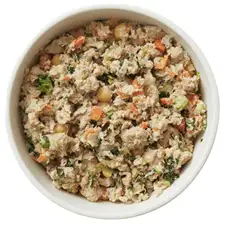 | The Farmer’s Dog Customized Human-Grade Dog Food
| CHECK PRICE |
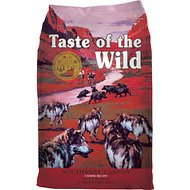 | Taste Of The Wild Southwest Canyon Grain-Free Dry Food
| CHECK PRICE |
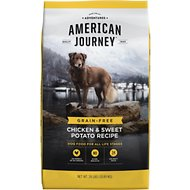 | American Journey Grain-Free Chicken & Sweet Potato Recipe
| CHECK PRICE |
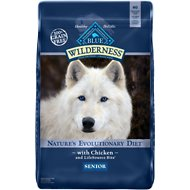 | Blue Buffalo Wilderness Senior Chicken Recipe Dry Food
| CHECK PRICE |
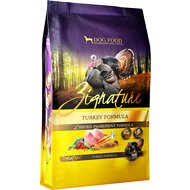 | Zignature Turkey Limited Ingredient Formula Dry Food
| CHECK PRICE |
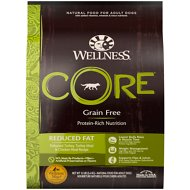 | Wellness CORE Grain-Free Reduced Fat Turkey & Chicken
| CHECK PRICE |
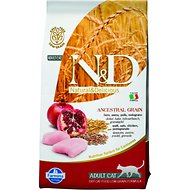 | Farmina Natural & Delicious Chicken & Ancestral Low-Grain
| CHECK PRICE |
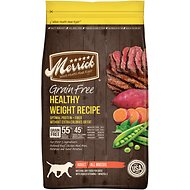 | Merrick Grain-Free Healthy Weight Recipe Dry Food
| CHECK PRICE |
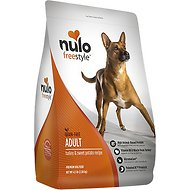 | Nulo Freestyle Turkey & Sweet Potato Recipe Grain-Free Dry Food
| CHECK PRICE |
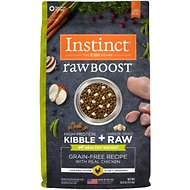 | Nature’s Variety Instinct Raw Boost Healthy Weight
| CHECK PRICE |
The Farmer’s Dog Customized Human-Grade Dog Food

Overall Best Diabetic Dog Food: When it comes to high-quality dog food, nothing is better than fresh. Fresh dog food made with wholesome, natural ingredients is the foundation of a healthy diet for any dog – not just a dog with diabetes. The Farmer’s Dog is a fresh food delivery service that sends pre-portioned packages of fresh dog food right to your door on a monthly basis.
You simply fill out a profile online using your dog’s basic information and then choose from several protein-rich, low-carbohydrate recipes. All of The Farmer’s Dog recipes are loaded with animal ingredients and come in a wide range of nutrient ratios and calorie concentrations so you can choose the right one for your dog.
You can rest easily knowing that every recipe is packed with premium protein and digestible grain-free carbohydrates with essential nutrients added for nutritional balance. Plus, your dog will love the natural flavor.
- Pros: Fresh food delivered monthly, pre-portioned according to dog’s needs, rich in protein, low in carbohydrates, grain-free and low-glycemic, complete and nutritionally balanced
- Cons: Expensive to feed as a staple diet, limited number of recipes
Taste of the Wild Southwest Canyon Grain-Free Dry Food

Most Popular Dog Food for Diabetes: If you’re not sure what to feed your dog, you can always go with a popular option like Taste of the Wild Southwest Canyon Grain-Free Dry Food. This brand is extremely popular because it features numerous premium animal proteins in grain-free recipes formulated for dogs of all life stages. This recipe is naturally grain-free, featuring low-glycemic carbohydrates like garbanzo beans and peas to provide dietary fiber and essential nutrients. This formula is rich in protein with moderate fat content and plenty of fiber, plus it is supplemented with dried fermentation products for additional probiotic support. This dog food contains chelated minerals as well, which have been chemically bound to protein molecules to increase their absorption. Overall, this is a rich source of nutrition for your diabetic dog.
- Pros: Rich in animal protein, low-glycemic grain-free carbohydrates, highly digestible, rich in fiber, moderate fat content, plenty of omega fatty acids for skin and coat, probiotics
- Cons: Some dogs may be sensitive to beef ingredients
American Journey Grain-Free Chicken & Sweet Potato Recipe

Most Affordable (Cheap) Dog Food for Diabetes: You don’t necessarily need to spend a fortune on a good dog food for diabetic dogs – you don’t even have to choose a prescription diet. One of our top picks for the best non prescription diabetic dog food options is this American Journey Grain-Free Chicken & Sweet Potato Recipe. It may not be specially developed for diabetic dogs, but it is rich in lean protein, free from high-glycemic grains, and supplemented for digestibility and balanced nutrition. Real chicken is the first ingredient in this recipe, and it is supplemented with chicken meal, turkey meal, and menhaden fish meal for a protein-rich diet that will help support your dog’s lean muscle mass. Grain-free carbohydrates like peas and sweet potatoes provide essential nutrients and fiber for healthy digestion, working with the probiotic supplements. This recipe also contains fresh fruits and veggies which provide natural sources for key nutrients to ensure complete and balanced nutrition.
- Pros: Rich in lean protein, digestible grain-free carbohydrates, plenty of fiber, fresh fruits and vegetables, rich in omega fatty acids for skin and coat, probiotic supplements
- Cons: Contains some plant protein (pea protein), some dogs may be sensitive to chicken ingredients
Blue Buffalo Wilderness Senior Chicken Recipe Dry Food

Best Diabetic Dog Food for Senior Dogs: Middle-aged and senior dogs have a higher risk for diabetes, particularly if they are overweight. If you’re looking for a senior recipe dog food that will help your dog maintain a healthy body weight that is also low-glycemic, we recommend Blue Buffalo Wilderness Senior Chicken Recipe Dry Food. This formula features deboned chicken as the first ingredient and a lean source of protein. It also contains grain-free, low-glycemic carbohydrates including peas and tapioca starch. This recipe is rich in omega fatty acids to support your dog’s skin and coat health with plenty of fiber for healthy digestion. Fresh fruits and vegetables provide natural sources for key vitamins, minerals, and antioxidants with chelated minerals to help ensure complete and balanced nutrition. Overall, this recipe provides 30% protein to help your dog maintain lean muscle mass with just 12% fat and a whopping 7% fiber.
- Pros: Rich in lean protein, digestible grain-free carbohydrates, low in fat high in fiber, rich in omega fatty acids, probiotics and supplemental fiber, fresh fruits and vegetables
- Cons: Some dogs may be sensitive to chicken ingredients, contains plant protein (pea protein)
Zignature Turkey Limited Ingredient Formula Dry Food

Best Diabetic Dog Food for Sensitive Stomach: If your dog suffers from food allergies or sensitive stomach, it may be difficult to find a dog food that won’t upset his stomach. This Zignature Turkey Limited Ingredient Formula Dry Food is a great option because it contains a limited number of main ingredients to reduce the risk for triggering an allergy and it contains a novel source of lean animal protein. This formula is packed with protein from both fresh turkey and turkey meal, plus it is made with digestible grain-free carbohydrates like chickpeas and peas. It may be a little higher in fat than some dogs need, but it is very high fiber and contains fresh fruits and vegetables to provide natural sources for key nutrients. This recipe is rich in omega-3 and omega-6 fatty acids for healthy skin and coat, plus it is supplemented with chelated minerals. Overall, it’s a great choice if you’re looking for a limited ingredient diet to keep your dog’s blood sugar stable.
- Pros: Rich in lean animal protein, blend of omega-3 and omega-6 fatty acids, digestible grain-free carbohydrates, fresh fruits and vegetables, high in fiber, chelated minerals
- Cons: May be too high in fat for some dogs, contains plant protein (pea protein)
5 More Top-Rated Glucose Management Dog Foods
If the five dog foods reviewed above don’t seem like the right fit for your dog, don’t worry! There are plenty of other options to choose from. Here are five more of the best diabetic dog food brands that we recommend for your diabetic dog:
Wellness CORE Grain-Free Reduced Fat Turkey & Chicken Recipe Dry Food

If your diabetic dog needs to lose weight, you need a recipe that will provide plenty of lean animal protein. This Wellness CORE Grain-Free Reduced Fat Turkey & Chicken Recipe Dry Food is a great option because it features both turkey and chicken as low-fat source of premium animal protein. This recipe is grain-free, relying on low-glycemic carbohydrates like peas to provide essential nutrients as well as dietary fiber. This dog food contains fresh fruits and vegetables to provide natural sources for key nutrients, balanced with vitamin and chelated minerals supplements. It is full of flavor but lower in fat and calories than the average kibble. IT is also packed with fiber and supplemented with probiotics.
- Pros: Rich in lean animal protein, digestible grain-free carbohydrates, fresh fruits and vegetables, blend of omega fatty acids, high in fiber, chelated mineral supplements, probiotics
- Cons: Fairly expensive to feed as a staple diet
Farmina Natural & Delicious Chicken & Ancestral Low-Grain Formula Dry Food

Many non prescription diabetic dog food options are grain-free but, if your dog can tolerate them, whole grains can provide a healthy source of nutrition. This Farmina Natural & Delicious Chicken & Ancestral Low-Grain Formula Dry Food is a great option because, while it does contain grains, they are low-glycemic and packed with powerful nutrients. This recipe features deboned chicken as the first ingredient and a rich source of lean protein with eggs and herring for supplemental protein. It contains whole grains like spelt and oats to deliver a blend of fiber, energy, and essential nutrients without going overboard. Simply put, this recipe is a good option if you’re looking for a low-glycemic, grain-inclusive recipe for your dog.
- Pros: Low-glycemic recipe, highly digestible, rich in lean animal protein, blend of omega-3 and omega-6 fatty acids, dried fruits and vegetables, chelated minerals, glucosamine and chondroitin
- Cons: Not a grain-free recipe (some dogs may be sensitive), may be too high in fat for some dogs
Merrick Grain-Free Healthy Weight Recipe Dry Food

This Merrick Grain-Free Healthy Weight Recipe Dry Food is designed to provide complete and balanced nutrition while keeping the fat and calorie content of the recipe low. It features real beef as the first ingredient, supplemented with chicken meal and turkey meal to provide a total of 34% protein. This recipe features digestible grain-free carbohydrates like peas and sweet potatoes to deliver low-glycemic energy and a natural source of key nutrients. It is supplemented with plenty of fiber as well as probiotic supplements for healthy digestion as well. This recipe contains chelated minerals which are chemically bound to protein molecules to increase absorption as well as vitamin supplements to ensure nutritional balance. Overall, it is a great choice for diabetic dogs who need to lose weight in a healthy way.
- Pros: Rich in animal protein, digestible grain-free carbohydrates, rich in omega fatty acids, high in fiber, probiotic supplements, nutritionally complete and balanced, chelated minerals
- Cons: Some dogs are sensitive to beef ingredients, contains some plant protein (potato protein)
Nulo Freestyle Turkey & Sweet Potato Recipe Grain-Free Dry Food

High-quality ingredients are the foundation of a healthy diet and this Nulo Freestyle Turkey & Sweet Potato Recipe Grain-Free Dry Food is full of them. This grain-free recipe is packed with 85% animal ingredients but free from chicken and egg proteins to reduce the risk for triggering food allergies and sensitivities. It contains grain-free carbohydrates like chickpeas and sweet potato, both of which are also low-glycemic carbohydrates. This formula is rich in omega-3 and omega-6 fatty acids for healthy skin and coat, plus it is supplemented with probiotics and plenty of healthy fiber for digestion. It contains nutrient-rich chicken fat as a concentrated source of energy with dried fruits and vegetables to provide natural sources for key nutrients as well.
- Pros: Rich in lean animal protein, digestible grain-free carbohydrates, rich in omega fatty acids, dried fruits and vegetables, high in fiber, chelated minerals, probiotic supplements
- Cons: May be too high in fat for some dogs
Nature’s Variety Instinct Raw Boost Healthy Weight Grain-Free Chicken Recipe

To help your dog achieve and maintain a healthy body weight while also supporting his nutrition, we recommend this Nature’s Variety Instinct Raw Boost Healthy Weight Grain-Free Chicken Recipe. This recipe features a combination of high-protein kibble and freeze-dried raw bites in a healthy, nutritious recipe that provides plenty of protein and fiber with moderate fat content and a low glycemic rating. It is made with fresh chicken as the main ingredient with turkey meal, chicken meal, and menhaden fish meal as supplemental sources of lean protein. This recipe is rich in omega fatty acids for healthy skin and coat, plus it contains fresh fruits and vegetables to provide natural sources for key nutrients. It is supplemented with probiotics for healthy digestion as well as vitamin and chelated mineral supplements to ensure complete and balanced nutrition.
- Pros: High-protein kibble and freeze-dried raw bites, several premium animal proteins, digestible grain-free carbohydrates, fresh fruits and vegetables, probiotics, rich in omega fatty acids
- Cons: Expensive to feed as a staple diet, some dogs may be sensitive to chicken ingredients
Frequently Asked Questions
What can I feed my diabetic dog?
Many owners of diabetic dogs choose to feed their dogs weight management formulas. These formulas are ideal for diabetic dogs because they are typically high in protein and fiber but lower in fat than the average kibble. Just make sure that your dog’s food is made from highly digestible, natural ingredients and free from high-glycemic carbs like wheat and corn. You should consider feeding your dog a formula designed for his breed size (small breed vs. large breed) as well as his life stage (puppy, adult, or senior) to ensure that his specific nutritional needs are being met. Aside from that, however, you have some freedom when it comes to choosing the specific recipe.
Why is my diabetic dog so hungry?
Excessive thirst and increased urination are two common symptoms of diabetes in dogs, but some dogs also become excessively hungry. When your dog’s body stops utilizing insulin properly, the cells are less able to absorb glucose from the bloodstream to use as energy. As a result, the body may start tapping into other sources of energy such as your dog’s fat stores. When your dog starts to lose weight and still isn’t able to absorb energy or nutrition, he may become very hungry.
How can I treat dog diabetes naturally?
If your dog’s body can’t produce enough insulin, he’ll need injectable insulin treatments to stabilize his blood sugar. In addition to these treatments, there are some natural methods for treating dog diabetes. It’s a good idea to keep your dog’s exercise habits and stress levels as consistent as possible while also managing his diet. His diet should be high in protein and fiber with low-to-moderate fat content and limited carbohydrate content. The food should be low-glycemic to avoid spiking your dog’s blood sugar, and it should be a high-quality source of digestible, balanced nutrition.
How much should a diabetic dog eat?
The amount of food to feed a dog doesn’t change just because he has diabetes. You may need to adjust your dog’s daily portion if he is overweight, but that’s another matter. The best thing to do is choose a recipe appropriate for your dog’s life stage and breed size then follow the feeding recommendations according to his age and weight. If he needs to lose weight, consider switching to a healthy weight formula or simply feed him the recommended amount for his goal weight. If your dog has a lot of weight to lose, consult your veterinarian because underfeeding an overweight dog could put him at risk for fatty liver disease or malnutrition.
How many times a day should a diabetic dog eat?
Most diabetic dogs receive twice-daily insulin injections, so you’ll also be giving your dog two daily meals. Many veterinarians recommend administering insulin injections after each meal so you can adjust the dosage according to your dog’s intake. Generally speaking, you’ll be feeding your dog two equal meals spaced about 10 to 12 hours apart.
Diabetic Dog Food – RECAP
Diabetes in dogs is a serious condition, but it is also a manageable one. The most important thing is to help your dog stay healthy, and that means achieving and maintaining a healthy body weight as well as stable blood sugar levels. You’ll need to talk to your veterinarian about insulin injections, but other than that you should focus on feeding your dog a high-quality diet.
If you’re not sure where to start in shopping for low glycemic dog food for diabetes, simply try one of our top-rated picks reviewed above. Best of luck!










